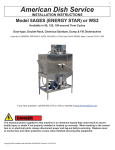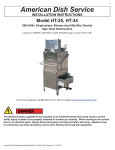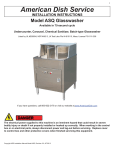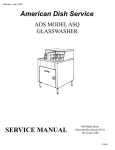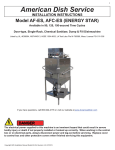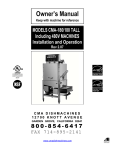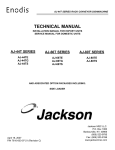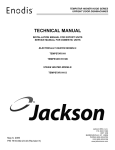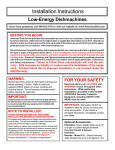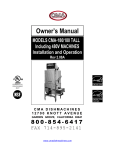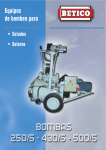Download Installation Manual ADC44 or ADC66 3ph
Transcript
1 American Dish Service INSTALLATION INSTRUCTIONS Model ADC-44 or ADC-66 208/240V, 3-ph, 60a or 90a for 66 High Temp or Chemical Sanitizer Conveyor Dishmachines Listed by UL #E68594, NSF/ANSI 3, ASSE 1004 #301, LA Test Labs File M-920011, Mass. License P3-0111-306 If you have questions, call 800-922-2178 or visit our website at www.AmericanDish.com The electrical power supplied to this machine is an imminent hazard that could result in severe bodily injury or death if not properly installed or hooked up correctly. When working in the control box or on electrical parts, always disconnect power and tag-out before servicing. Replace cover to control box and other protective covers when finished servicing this equipment. Copyright ADS Installation Manual Model ADC-44/66 3-PH, Revision 3.0, 6/7/2013 2 READ Manufacturer’s Manual before Using this Product. For your safety read and observe all cautions shown throughout these instructions. While performing installations described in this booklet, wear approved Personal Protective Equipment, including Safety Eye-Wear. CHEMICALS— There are potentially hazardous situations when working with industrial cleaning chemicals for dishmachines. See chemical manufacturer’s safe practices and MSDS sheets for handling and installing chemicals and supply containers. #1 BEFORE YOU BEGIN— American Dish Service provides this information as a service to our customers. Keep all instructions for future reference. ADS reserves the right to alter or update this information at any time. Should you desire to make sure that you have the most up-to-date information, we would direct you to the appropriate document on our web site: www.americandish.com. Set out below are the specifications and requirements that you must use and follow to properly install the type or types of equipment listed above. It is your obligation as the customer to ensure that the machine is installed safely and properly, and when completed, the machine is left in proper and safe working order. Electrical, Plumbing, and Chemical hookup should be performed by a qualified professional who will ensure that the equipment is installed in accordance with all applicable Codes, Ordinances, and Safety requirements. Failure to follow the installation instructions could void the warranty. ADS assumes no liability or control over the installation of the equipment. Product failure due to improper installation is not covered under the ADS Warranty. #2 HEAVY USE ITEM— A conveyor dishmachine is often run at full capacity. The machine is not rated for outdoor use. #3 FLUSH OUT INITIAL FILL WATER— Do not install spray arms until machine is flushed with water. When this machine is connected to power, it will normally fill with water . Do this without installing the spray arms. Place a rack inside the machine so all the pumps will run. Afterward, drain all the water from the tanks, install all spray arms, and refill the machine. To drain, pull the pump filter out of the sump and the stand tube from the rinse tank (for the 66, also pull the large scrap basket from the power scrapper tank). #4 CLEARANCES—Dishmachines must be installed to allow for servicing of motors and conveyor systems. Do not install chemical dispensers on the top of the control box, machine, or booster. #5 WATER HEATERS—or boilers must provide the minimum temperature of 120°F required by the machines listed above, which have a minimum hourly demand of 120 gallons per hour. For HOT WATER SANITIZING, a booster heater must be installed to achieve the 180°F minimum for the final rinse. This booster will require a rise of 70°. These specifications are for the dishmachine only, which typically accounts for 70% of a restaurant’s hot water demand. #6 INSPECT FOR DAMAGE—If you receive a damaged dishmachine, do not sign “Clear” but write “Damaged” on the documents. Copyright ADS Installation Manual Model ADC-44/66 3-PH, Revision 3.0, 6/7/2013 3 #7 TABLES— are critical to proper dishmachine operation. No table drains (quick drains) or sinks within 20” of the dishmachine on soil table. No sinks or drains on clean tables. Slant tables toward the machine and anchor to the machine lip with ¼” bolts supplied. Table lip must not rub on the conveyor bar. If needed, cut out a half-round in the table lip for clearance of the conveyor bar. Tray tracks are not adjustable up or down because of the switch activators. Fasten tables to the machine so they are level with the tray track. Curves or “bands” on clean table seldom work correctly, we recommend using ADS table limit switch (kit 288-1044) for short exit tables. ELECTRICAL SECTION The electrical power supplied to this machine is an imminent hazard that could result in severe bodily injury or death if not properly installed or hooked up correctly. #1 Before powering up the machine, CHECK ALL ELECTRICAL SCREW TERMINALS in the control box on top of the machine, power box, and both heater boxes located under the tanks. Screws can loosen in transit. Loose connections on high amp load terminals will cause wire burning and component damage during operation and will not be covered under ADS warranty. The term “Clean Circuit” means the electrical circuit breaker supplies no other devices, motors, machines, or lights. #2 ADS Conveyor models DO NOT INCLUDE an internal booster heater. Boosters must be installed separately, ADS recommends a 27 kW for 155 GPH at a 70°rise. ADC-44 conveyor control box for 3-phase power Main distribution block for 44’s incoming 3-phase Electrical ADC-44, 208v/240v, 3-ph, 60a ORDERING INSTRUCTIONS—Machines with heaters are voltage specific, order according to actual voltage at the installation (see kW chart in appendix) The power supply of 208 volts, 60 amps must consist of three 6-gauge wires and a suitable ground. The 60 amp breaker or fuses must be on a clean circuit to the machine. ADS has provided a conduit hole (1 3/8”actual size) for 1” conduit for the electrical service into the back of the control box. Attach the 6-gauge wires to the main distribution block in the control box to terminals marked L1, L2, & L3. Attach a building ground wire to the main distribution block marked GND and tighten all wires. Copyright ADS Installation Manual Model ADC-44/66 3-PH, Revision 3.0, 6/7/2013 4 FOR 240 VOLT OR DELTA SYSTEMS—attach the high leg (200 volt line) to L3. Attach your 120 volt lines to L1 and L2. If power is 240v, see kW rating chart at the back of the manual for correct heater sizing and available ADS heater elements. 3-Phase MOTOR ROTATION—Remove front panels and check rotation of motors. A rotational arrow is placed on the wash pump motor. If this motor is running in reverse of the arrow, turn off main power and switch the incoming power wires on L1 & L2. This step will correct the rotation of the other motors at the same time. Verify proper rotation and tighten all wires. ADC-66 conveyor control box for 3-phase power Main distribution block for 66’s incoming 3-ph, note Neutral Electrical ADC-66, 208v/240v, 3-ph, 90a, w/10-gauge neutral ORDERING INSTRUCTIONS—Machines with heaters are voltage specific, order according to actual voltage at the installation (see kW chart in appendix) The power supply (208 volt, 90 amps) must consist of three 3-gauge wires, a 10-gauge neutral, and a suitable ground. The 90 amp breaker or fuses must be on a clean circuit to the machine. ADS has provided a conduit hole (1 3/4”actual size) for 1 1/4” conduit for electrical service in the back of the control box. Attach the 3-gauge wires to the main distribution block in the control box, to terminals marked L1, L2, & L3. Attach 10-gauge neutral and ground wire to their proper locations on the main distribution block and tighten all wires. FOR 240 VOLT OR DELTA SYSTEMS— attach the high leg (200 volt line) to L3. Attach your 120 volt lines to L1 and L2. If power is 240v, see kW rating chart at the back of the manual for correct heater sizing and available ADS heater elements. 3-Phase MOTOR ROTATION—Remove front panels and check rotation of motors. A rotational arrow is placed on the wash pump motor. If this motor is running in reverse of the arrow, turn off main power and switch the incoming power wires on L1 & L2. This step will correct the rotation of the other motors at the same time. Verify proper rotation and tighten all wires. IT IS RECOMMENDED THAT THIS EQUIPMENT BE INSTALLED USING A NEW CIRCUIT BREAKER. Copyright ADS Installation Manual Model ADC-44/66 3-PH, Revision 3.0, 6/7/2013 5 PLUMBING SECTION #1 TANKLESS WATER HEATERS can be problematic for commercial dishmachines. The ADS models ADC-44/66 dishmachines require heated water 120 gallons per hour at 20 psi as measured at the final rinse manifold, with a minimum temperature of 120°F. It has been the experience of ADS that tankless supply systems require multiple units plumbed in sequence with a recirculation loop to achieve proper pressure and temperature. Check with the tankless water heater manufacturer, they may recommend a storage tank to guarantee proper flow and line pressure to the machine. Failure to provide adequate water quantity, pressure and temperature to the machine will cause the machine to function improperly and is not the responsibility of ADS. Improperly installing ADS equipment in this manner could void the warranty. All costs associated with providing an adequate water supply to the machine is the sole responsibility of the user. #2 DRAIN SIZE—Gravity drain lines are 2” pipe size. Do not use reducing adapters for drain lines, always use same diameter pipe or larger. Close pump petcocks if equipped. #3 A PRESSURE REDUCING valve with by-pass should be installed before the booster heater if the line pressure is 50 psi or above. This is according to booster manufacturer’s instructions. #4 BURN HAZARD from hot water from pump sprays or plumbing leaks. ELECTRICAL SHOCK HAZARD on bare electrical terminals in the thermostat boxes, power box, float switch boxes, and control box. #5 #6 HOODS—Follow all local plumbing and mechanical codes. IMC 2012, section 507.2.2 requires Type II hoods for all commercial dishwashers except where the heat and moisture loads are incorporated into the building’s HVAC systems or dishwashing equipment designed with separate heat and moisture removal systems. A conveyor-type, hot-water sanitizing dishwasher is rated at 21,720 Btu/h by table 5E, ASHRAE Research Project #1362, 8/5/2008. ADS DOES NOT SPECIFY BUILDING HVAC VALUES. Hot water inlet manifold, single point ¾” pipe, PR valve Flush building’s water lines before connecting to dishmachine. Copyright ADS Installation Manual Model ADC-44/66 3-PH, Revision 3.0, 6/7/2013 Final rinse manifold with pressure gauge, 20 psi flow req. 6 DUAL SANITIZING MODE Hot Water Sanitizer Connection For high temp sanitizing this line will come from a stand-alone booster heater. Connect ¾” MPT water supply line to the 90° elbow of the dishmachine’s inlet manifold. The requirement at the dishmachine is 180° F minimum at 20 PSI during final rinse flow, 120 GPH. This is measured at the pressure gauge mounted next to the pressure reducing valve in the inlet plumbing on top of the machine’s hood. To adjust pressure, turn adjustment screw atop the valve counter-clockwise to decrease pressure. Chemical Sanitizer Connection For chemical sanitizing this line will come directly from the building’s water heater. Connect ¾” MPT water supply line to the 90° elbow of the dishmachine’s inlet manifold. The requirement at the dishmachine is 120° F minimum at 20 PSI during final rinse flow, 120 GPH. This is measured at the pressure gauge mounted next to the pressure reducing valve in the inlet plumbing on top of the machine’s hood. To adjust pressure, turn adjustment screw atop the valve counter-clockwise to decrease pressure. A dispenser with three product pumps is required for chemical sanitizing (chlorine pump). Drain Requirements Showing 2” drain manifold exiting sump & scrap box Scrap box and tray ADS provides a 2” copper common drain that exits on the soil side of the dishmachine under the scrap box (ADC-66 drain exits both sides). To prevent clogging, run drain lines as straight as possible. Do not plumb with tight radius elbows or 180° bends. Use of floor sinks for drains can cause flooding. Do not use reducing adapters for drain lines, always use 2” diameter pipe or larger. Always run gravity drain lines downhill. DISPENSER HOOK-UP SECTION You must wear approved safety eye-wear before connecting chemical equipment. Commercial cleaning chemicals are harmful and can cause damage to the plumbing and stainless steel of the dishmachine. Do not mount dispensers on the control box or run chemical lines over controls or plumbing. Always secure chemical lines and check regularly for leaks. If not properly handled, chemicals can cause serious bodily injury. In the event of chemical contact to skin or eyes; wash immediately with fresh water and seek medical attention. Copyright ADS Installation Manual Model ADC-44/66 3-PH, Revision 3.0, 6/7/2013 7 There is NO CHEMICAL DISPENSER included with this model. Chemical dispensers must be provided and installed prior to operation. The installation of the dispenser is typically provided by the chemical supplier. Mixing chamber with two 1/8” pipe threaded ports Hi-temp mixing chamber is SS, Chemical is a polymer Showing 7/8” detergent probe hole behind pump motor ADS provides two (2) ports, 1/8” IPS female threads in the final rinse mixing chamber for dispenser check valves. Probe hole (7/8”) is provided in the wash tank for probe installations (install probe before operating the machine). Detergent hole (7/8”) is provided for bulk-head fitting (install fitting before operating machine). Showing hole at the side of tank, 7/8” detergent fitting Dispenser signal connection terminals in control box NOTE: Before turning on the water, if the chemical dispenser has not been installed, plug the probe and chemical delivery holes in the wash tank and plug the mixing chamber injection ports. ADC-44, 3-phase provides 240v dispenser signals (transformer control voltage). ADC-66, 3-phase provides 120v dispenser signals. Connect to chemical dispenser terminal blocks located on the left-hand side of the control box, look for yellow decal labeled detergent and rinse. TESTING FOR TEMPERATURE—For high temp sanitizing, the measurement is taken at the manifold for a minimum of 180°F, NOT in or at the sprays. If color changing tapes are used to verify temperature, then only 165°F labels should be used, this is the highest temperature required on the surface of the plates-NOT 180°F. This is according to the NSF/ANSI Standard 3 test protocol. Copyright ADS Installation Manual Model ADC-44/66 3-PH, Revision 3.0, 6/7/2013 8 TYPE OF CHEMICALS—Use only commercial grade low-energy or high temp chemicals. For proper operation, use non-foaming detergents and buffered sanitizer. Do not wash gold, pewter, silver, or silver-plate with chlorine based sanitizers. High concentrations of chlorine sanitizers and caustic detergents will cause damage to metals and welds. Do not exceed 50 parts-per-million (PPM) “free” or available chlorine, using higher than 50 ppm will be dependent on local health requirements, however, the increased chlorine will result in higher corrosion of metal parts. The resulting damage from overusing chlorine is not covered under the ADS warranty. Purpose-built ware-washing dispensers are needed to properly meter chemicals for wash and rinse. These dispensers are not included with this model but must be installed by the company that provides the ware-washing chemicals. Manually adding industrial chemicals to the dishmachine is unsafe and not approved. HARD WATER—Water softeners should be used to correct hard water conditions. Treating hard water conditions with highly acid solutions in the machine is discouraged. Hard water conditions are often treated with more expensive dishmachine chemicals, but it is more effective and less destructive to the metal when the water is softened before it is used by the dishmachine. CHECK LIST PRIOR TO INITIAL START UP Open doors and remove all packaging, including cardboard supports under the wash tank heater. Do not dispose of packing material until you remove spray arms and curtains. Packing materials contain the conveyor installation manual, QC check sheets, curtains; upper and lower wash arms, pumped rinse arms, and power scrapper arms for the ADC-66. Showing wash arm T index for lower arm Arm resting in “T” index with latch down Showing pumped rinse manifold locking tab Rinse arm index notch, latch will drop as arm is pushed in Copyright ADS Installation Manual Model ADC-44/66 3-PH, Revision 3.0, 6/7/2013 9 Install wash and pumped rinse spray arms. Lower wash arm has eight spray tubes and upper wash arm has four. Install each by inserting indexed “T” end into bracket at front of tank, and then push the arm back until the round socket is fully inserted on the wash manifold near the back wall. Position the “T” bracket latch to secure wash arms in place by pulling down. Install power scrapper arms (ADC-66 only) and pumped rinse spray arms. Each arm has a locking tab. Lower arm locking tabs are located on the same side as the spray jets. Upper arm locking tabs are opposite the spray jets side. Insert the tab into the index slot of each manifold socket until socket catch locks in place. Note: make sure that spray jets on the bottom arms spray up, and top arms spray down. ADC-66 power scrapper, overflow to scrap box 66 power scrapper motor, 1.5 HP, 208v, single-phase Inspect all dish racks for broken ladders. Dispose of any broken dish racks. IMPORTANT TABLE INSTRUCTIONS— Allow for one rack (20”) length as a minimum distance between the edge of the pre-rinse sink and the entrance of the machine on the soil dish table. Failure to do this will result in excessive chemical consumption and low temperatures. Do not use tables with quick drains or scrap troughs. Observe that the dish table lip does not rub on the conveyor bar; if the lip is longer than ¾” a notch will have to be made for clearance. Make certain that both dish tables slant into the machine so water will return to the tanks. Bolt the tables to the machine and seal. TABLE LIMIT SWITCH—Check clean dish table, if it holds less than four (4) dish racks, install an ADS table limit switch (#288-1044). The switch holder attaches to the back side of the table end. The bumper bar will extend through the table and pin to the rocker plate. When racks strike the bar, the switch will break the power connection in the machine’s door cut-off switch, which stops all motors. ADS table limit, and table bumper bar (#288-1044) Copyright ADS Installation Manual Model ADC-44/66 3-PH, Revision 3.0, 6/7/2013 10 Tighten all wire connections looking for those that loosened during shipping or moving. Turn on the water supply. Check and correct any leaks throughout the machine. Verify incoming water temperatures and final rinse pressure (20 psi during spraying). Remove any of the white protective film from stainless surfaces such as doors or panels. DISHMACHINE OPERATIONAL TESTS BURN HAZARD FROM HOT WATER. Do not open doors while machine is in cycle. Doing so could result in serious bodily injury from spraying hot water and chemicals. To operate, turn on the breaker for main power and turn the dishmachine master switch to the “ON” position. Showing “float” switch that controls fill water & heater Showing “float” switch that controls fill water & heater FILLING THE MACHINE— When the machine is first turned on, water will automatically fill to an initial working level. During operation the water level will normally increase with each rack until water begins to exit the overflow into the scrap box. Open the access door and verify that the filling water is adjusted so the wash tank fills first and rinse tank fills last. For the ADC-66 the wash tank must overflow to fill the power scrapper tank. The last tank to fill should be the pumped rinse tank. If the fill sequence does not follow this order, adjust the diverter plate inside the hood, it is located upward near the water inlet (see photo above). Slotted holes allow the diverter plate to move side to side adjusting the flow to the rinse tank. The water stream going into the pumped rinse tank should be about the diameter of a pencil. It is normal for the machine to add more water when the pump turns on if the level has not yet reached the overflow. Copyright ADS Installation Manual Model ADC-44/66 3-PH, Revision 3.0, 6/7/2013 11 Rinse tank float, pump filter, pumped rinse manifold Wash tank float and tank overflow “FLOAT” AND SWITCH—the float will not actually float. It is heavier than water but it weighs less in water than in air. This difference allows the return spring in the float switch to push out against the lever, which raises the float in the water. In air the float’s weight will overcome the switch’s spring tension and drop down. The float switch (#291-3014) is specifically made with this spring tension so the water control system will operate correctly. Do not replace with a timer switch even though they look similar. Travel through conveyor tray rails, center pull bar w/dogs Damaged and broken rack that will jam or skip conveyor TEST DISH RACK CONVEYOR MOVEMENT by placing a rack into the soil side opening until it catches on a conveyor dog. The rack should enter and exit smoothly without jamming. The dishmachine tray track will not adjust up or down, it is fixed. Tables must sit on the tank lip. Verify that tables are bolted to the machine, and once bolted, sealed with silicone caulking at all four corners and under the lip. Check that all varieties and brands of dishrack can fit between the dishmachine’s tray track rails without binding. If binding occurs, adjust the REAR tray track at all (3) anchor points until the rack binding is eliminated. You must adjust evenly at all three points to maintain proper alignment. Never adjust the front tray track, they contain switching alignments. Copyright ADS Installation Manual Model ADC-44/66 3-PH, Revision 3.0, 6/7/2013 12 Conveyor cam blocks A & B Rocker arm slip clutch spring, hook to bar weldment Cam bearing screws into cam block B Rocker arm attached to conveyor bar, drip chute Keep away from conveyor rocker arm movement to avoid severe bodily injury from pinch or crush danger THE FRONT TRAY TRACK has sequence bars that turn on the pumps at each station of the dishmachine’s operation. There is a sequence bar for the power scrapper (on the ADC-66 only), wash, and final rinse sections. To confirm proper operation, push a dishrack into the soil side opening and see that it is conveyed through each section without binding or stoppages. POWER SCRAPPER (ADC-66 only) – Run one dishrack through the machine. Following initial fill, if there is an air lock in the scrapper pump, this is normal. The pump will equalize after being operated once. The power scrapper pump motor is the standard ADS single-phase 1.5HP motor wired for 208v instead of 115v. Make certain replacement motors are first wired for high voltage (see diagram on motor). WASH SECTION – Verify that the wash sequence bar starts the wash pump when the dishrack contacts the bar, and the pump stops when the dishrack moves out of that section of the dishmachine. Copyright ADS Installation Manual Model ADC-44/66 3-PH, Revision 3.0, 6/7/2013 13 FINAL RINSE SECTION – The last sequence bar will control the final rinse and pumped rinse. The pumped rinse, which is called the water curtain, should begin when a dishrack contacts the bar. This is a low pressure spray and the lower spray should only rise 4-6” from the arm. After a six second delay, the final rinse will begin to spray. All functions should stop when the dishrack exits the machine unless there is another rack still inside. Sequence reed switch for wash tank Wash tank sequence bar, pendulum with magnet SEQUENCE BAR MAGNETS— The magnets located on the pendulum sequence bars inside the tank activate the reed switches, which are manufactured in the normally closed position (always on). The reed switch is mounted to the outside of the tank and turns off when a magnet comes within ½” of the switch. To test, hold a strong hand-held magnet next to the reed switch. If the magnet turns off the reed switch but the sequence bar magnet does not, adjust the sequence bar magnet for that section. The sequence bar magnet should be within a 1/8” of the bottom of the tank when it is at rest (hanging down at the 6:00 position). TANK TEMPERATURE—The wash and pumped rinse tank temperatures are maintained by sustainer heaters. Record tank temperatures during the initial tests. There are three (3) gauges mounted under the control box. Gauges are marked Wash/Rinse/Final Rinse. Wash tank temperature should be 140°F for chemical sanitizing and 150°F for hot water sanitizing in multi-tank conveyors. The pumped rinse tank temperature should be 120°F for chemical and 160°F for hot water sanitizing. If tank temperatures are low, increase by adjusting the heater thermostats located behind the front panels. Wash tank thermostat, rotate center rod Left to increase Copyright ADS Installation Manual Model ADC-44/66 3-PH, Revision 3.0, 6/7/2013 T-stat signal goes to term #6 on heater relay under contactor 14 THERMOSTATS—There are two thermostats, one for each tank. Increase temp by turning center rod of the thermostat counter clock-wise or turn to the left. Adjust thermostats in small increments (1/4 turn). Heaters are switched off when water levels are low and the fill has been activated. Final rinse temperatures are 120°F for chemical sanitizers, and 180°F for hot water sanitizing. To increase the final rinse temperatures turn up the thermostat on the booster heater or water heater respectively. Do not set a booster heater above 195°F . INSTALL CURTAINS— There are two short and two long curtains. Longer curtains are mounted at each end of the dishmachine. Curtains are there to keep heat in the water. Vent attachments to end shield, 4” x 16” opening 200 to 400 CFM draw per side VENTING—If exhaust vents (pant-leg vents) are attached to the dishmachine, do not exceed 400 CFM per individual pant leg. ADS does not specify building HVAC values and only offers this limit as a point of reference. Showing repair of loose end cap when tab on the cap has been forced close or bent on material such as seeds or tooth picks. Tab on endcap bent inward, causing loose fit Copyright ADS Installation Manual Model ADC-44/66 3-PH, Revision 3.0, 6/7/2013 Straighten tab in line with the coin edge to tighten latch 15 Conveyor drive, cam blocks, bearing, clutch springs (use caution) APPENDIX 089-9342---44” Conveyor Parts Manual 089-9421---44” Spec sheet 089-9346---44” Service Manual 089-9437---44” Brochure 089-9365---44” & 66” Conveyor Wall Chart 089-9454---44” Wire diagram 089-9388---Installation Manual ADC-44/ADC-66 3 Phase 089-9343---66” Conveyor Parts Manual 089-9423---66” Spec Sheet 089-3408---66” Service Manual 089-9439---66” Brochure 089-9456---66” Wire Diagram Copyright ADS Installation Manual Model ADC-44/66 3-PH, Revision 3.0, 6/7/2013 Conveyor motor control relays 16 ADC-44 Conveyor Voltage 208v 240v Phase 3 3 Full Load Amps 50a 52a ADC-66 Conveyor Full Load Voltage Phase Amps 208v 3 68.8a 240v 3 76.6a Heaters are voltage specific, meaning voltage makes a difference in the wattage output of the heater. The following chart will list the wattage (kW) output for various available 3-phase voltages. Also listed are the ADS tank heaters available to match those voltages. Heater Rated 12kW 208v * (291-9009) 12kW 220v (291-9001) 14kW 208v (291-9008) 18kW 220v ** (291-9007) 8kW 208v (391-9001) 2.25kW 208v (291-9003) Supplied Actual Volts Output Amp Draw Phase 200 volts 208 volts 220 volts 240 volts 200 volts 208 volts 220 volts 240 volts 200 volts 208 volts 220 volts 240 volts 200 volts 208 volts 220 volts 240 volts 200 volts 208 volts 220 volts 240 volts 200 volts 208 volts 220 volts 240 volts 32.0a 33.4a 35.3a 38.4a 28.6a 29.7a 33.4a 34.4a 37.4a 38.9a 41.1a 44.8a 42.9a 44.7a 47.3a 51.5a 21.4a 22.2a 23.4a 25.5a 6.0a 6.2a 6.6a 7.2 a 3-ph 3-ph 3-ph 3-ph 3-ph 3-ph 3-ph 3-ph 3-ph 3-ph 3-ph 3-ph 3-ph 3-ph 3-ph 3-ph 3-ph 3-ph 3-ph 3-ph 3-ph 3-ph 3-ph 3-ph 11.1 kW 12.0 kW 13.42 kW 15.9 kW 9.9 kW 10.7 kW 12.0 kW 14.3 kW 12.9 kW 14.0 kW 15.66 kW 18.6 kW 14.8 kW 16.1 kW 18.0 kW 21.4 kW 7.4 kW 8.0 kW 8.9 kW 10.6 kW 2.079 kW 2.250 kW 2.515 kW 2.993 kW *Normal tank heater ADC-44, 3-phase is 208v, 12kW, --240v, 12kW is special order **Normal tank heater for ADC-66 Copyright ADS Installation Manual Model ADC-44/66 3-PH, Revision 3.0, 6/7/2013 17 ADC-44 Conveyor for 3-phase, 208-240v power 120V CONTROL CIR. GN L3 L2 L1 MASTER SWITCH 120V TERM. BARS TRANSFORMER BLACK WHITE POWER CONNECTION FINAL RINSE RELAY DOOR SW 60 AMP, 6 AWG WIRES III PHASE, 60 HZ PURPLE CLEAN CIRCUIT REQ. BLUE PLUS GROUND WIRE BLACK RINSE REED SW BLUE BROWN 240V HIGH LEG ON L3 BLUE RINSE RELAY WASH REED SW RED BROWN RED BLACK WHITE WASH RELAY WHITE FILL SOLENOID WASH TANK FLOAT SW BLACK WHITE ORANGE FINAL RINSE SOLENOID RINSE TANK FLOAT SW BLACK YELLOW OVERLOAD RINSE MOTOR 1/3 HP, 1 AMP 2.8, 3.9, 1.7 (4, 5, 6) WHITE MOTOR CONTACTOR RINSE DETER DISP HOOKUP BROWN OVERLOAD CONVEYOR MOTOR 1/3 HP, 1 AMP (Slave Contacts) MOTOR CONTACTOR RED N/O CONTACT SWITCH OVERLOAD WASH MOTOR 3HP, 8 AMPS YELLOW Thermostat Relay 50 AMP HEATER CIR. BRK. 2.8, 3.9, 1.7 (4, 5, 6) HOOD FAN (OPTION) MOTOR CONTACTOR RINSE TANK SUSTAINER HEATER THERMOSTAT TANK HEATER CONTACTOR 2.25 KW Thermostat Relay WASH TANK SUSTAINER HEATER THERMOSTAT TANK HEATER CONTACTOR Copyright ADS Installation Manual Model ADC-44/66 3-PH, Revision 3.0, 6/7/2013 12 KW, 33 A @ 220v 18 ADC-66 Conveyor for 3-phase, 208-240v power 120V CONTROL CIR. GN L3 L2 L1 MASTER SWITCH 120V TERM. BARS BLACK FINAL RINSE RELAY WHITE POWER CONNECTION 90 AMP, 3 AWG WIRES III PHASE, 60 HZ CLEAN CIRCUIT REQ. PLUS GROUND WIRE DOOR SW PURPLE BLUE BLACK RINSE N/C REED SW BLUE BROWN 240V HIGH LEG GOES ON L3 BLUE RINSE RELAY WASH N/C REED SW RED BROWN WHITE BLACK RED WASH RELAY BLACK SCRAP N/C BASKET N/O REED SW REED SW BROWN WHITE SCRAPPER RELAY BLACK WHITE FILL SOLENOID WASH TANK FLOAT SW BLACK WHITE ORANGE FINAL RINSE SOLENOID RINSE TANK FLOAT SW BLACK YELLOW BLACK POWER SCRAPPER MOTOR OVERLOAD WHITE 1.5 HP, 7.5 AMPS, I PH MOTOR CONTACTOR OVERLOAD RINSE MOTOR 1/3 HP, 1 AMP 2.8 3.9 1.7 (4, 5, 6) WHITE MOTOR CONTACTOR RINSE DETER DISP HOOKUP BROWN OVERLOAD CONVEYOR MOTOR (Slave Contacts) MOTOR CONTACTOR RED N/O CONTACT SWITCH OVERLOAD WASH MOTOR 3 HP, 8 AMPS YELLOW Thermostat Relay MOTOR CONTACTOR BROWN 20 AMP HEATER CIR. BRK. 1/3 HP, 1 AMP 2.8 3.9 1.7 (4, 5, 6) HOOD FAN (OPTION) RINSE TANK SUSTAINER HEATER THERMOSTAT 2.25 KW, 6 AMPS TANK HEATER CONTACTOR BROWN 2.25 KW Thermostat Relay WASH TANK SUSTAINER HEATER 60 AMP HEATER CIR. BRK. THERMOSTAT BLACK Copyright ADS Installation Manual Model ADC-44/66 3-PH, Revision 3.0, 6/7/2013 TANK HEATER CONTACTOR 18 KW, 48 AMPS


















